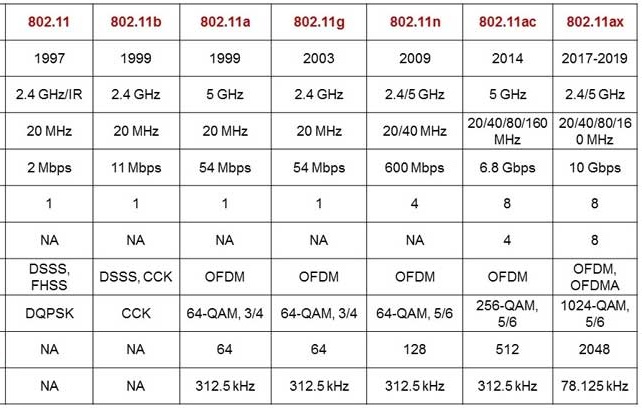802.11a/b/g/n/ac Development and Differentiation
Since the first release of Wi Fi to consumers in 1997, the Wi Fi standard has been constantly evolving, typically increasing speed and expanding coverage. As functions were added to the original IEEE 802.11 standard, they were revised through its amendments (802.11b, 802.11g, etc.)
802.11b 2.4GHz
802.11b uses the same 2.4 GHz frequency as the original 802.11 standard. It supports a maximum theoretical speed of 11 Mbps and a range of up to 150 feet. 802.11b components are cheap, but this standard has the highest and slowest speed among all 802.11 standards. And due to 802.11b operating at 2.4 GHz, home appliances or other 2.4 GHz Wi Fi networks may cause interference.
802.11a 5GHz OFDM
The revised version “a” of this standard is released simultaneously with 802.11b. It introduces a more complex technology called OFDM (Orthogonal Frequency Division Multiplexing) for generating wireless signals. 802.11a provides some advantages over 802.11b: it operates in the less crowded 5 GHz frequency band and is therefore less susceptible to interference. And its bandwidth is much higher than 802.11b, with a theoretical maximum of 54 Mbps.
You may not have encountered many 802.11a devices or routers. This is because 802.11b devices are cheaper and becoming increasingly popular in the consumer market. 802.11a is mainly used for business applications.
802.11g 2.4GHz OFDM
The 802.11g standard uses the same OFDM technology as 802.11a. Like 802.11a, it supports a maximum theoretical rate of 54 Mbps. However, like 802.11b, it operates in congested 2.4 GHz frequencies (and therefore suffers from the same interference issues as 802.11b). 802.11g is backward compatible with 802.11b devices: 802.11b devices can connect to 802.11g access points (but at 802.11b speeds).
With 802.11g, consumers have made significant progress in Wi Fi speed and coverage. Meanwhile, compared to previous generations of products, consumer wireless routers are becoming better and better, with higher power and better coverage.
802.11n (Wi Fi 4) 2.4/5GHz MIMO
With the 802.11n standard, Wi Fi has become faster and more reliable. It supports a maximum theoretical transmission rate of 300 Mbps (up to 450 Mbps when using three antennas). 802.11n uses MIMO (Multiple Input Multiple Output), where multiple transmitters/receivers operate simultaneously at one or both ends of the link. This can significantly increase data without requiring higher bandwidth or transmission power. 802.11n can operate in the 2.4 GHz and 5 GHz frequency bands.
802.11ac (Wi Fi 5) 5GHz MU-MIMO
802.11ac boosts Wi Fi, with speeds ranging from 433 Mbps to several gigabits per second. To achieve this performance, 802.11ac operates only in the 5 GHz frequency band, supports up to eight spatial streams (compared to the four streams of 802.11n), doubles the channel width to 80 MHz, and uses a technology called beamforming. With beamforming, antennas can basically transmit radio signals, so they directly point to specific devices.
Another significant advancement of 802.11ac is Multi User (MU-MIMO). Although MIMO directs multiple streams to a single client, MU-MIMO can simultaneously direct spatial streams to multiple clients. Although MU-MIMO does not increase the speed of any individual client, it can improve the overall data throughput of the entire network.
As you can see, Wi Fi performance continues to evolve, with potential speeds and performance approaching wired speeds
802.11ax Wi Fi 6
In 2018, the WiFi Alliance took measures to make WiFi standard names easier to recognize and understand. They will change the upcoming 802.11ax standard to WiFi6
Wi Fi 6, where is 6?
The several performance indicators of Wi Fi include transmission distance, transmission rate, network capacity, and battery life. With the development of technology and the times, people’s requirements for speed and bandwidth are becoming increasingly high.
There are a series of problems in traditional Wi Fi connections, such as network congestion, small coverage, and the need to constantly switch SSIDs.
But Wi Fi 6 will bring new changes: it optimizes the power consumption and coverage capabilities of devices, supports multi user high-speed concurrency, and can demonstrate better performance in user intensive scenarios, while also bringing longer transmission distances and higher transmission rates.
Overall, compared to its predecessors, the advantage of Wi Fi 6 is “dual high and dual low”:
High speed: Thanks to the introduction of technologies such as uplink MU-MIMO, 1024QAM modulation, and 8 * 8MIMO, the maximum speed of Wi Fi 6 can reach 9.6Gbps, which is said to be similar to a stroke speed.
High access: The most important improvement of Wi Fi 6 is to reduce congestion and allow more devices to connect to the network. Currently, Wi Fi 5 can communicate with four devices simultaneously, while Wi Fi 6 will allow communication with up to dozens of devices simultaneously. Wi Fi 6 also uses OFDMA (Orthogonal frequency-division multiple access) and multi-channel signal beamforming technologies derived from 5G to improve Spectral efficiency and network capacity respectively.
Low latency: By utilizing technologies such as OFDMA and SpatialReuse, Wi Fi 6 enables multiple users to transmit in parallel within each time period, eliminating the need for queuing and waiting, reducing competition, improving efficiency, and reducing latency. From 30ms for Wi Fi 5 to 20ms, with an average latency reduction of 33%.
Low energy consumption: TWT, another new technology in Wi Fi 6, allows AP to negotiate communication with terminals, reducing the time required to maintain transmission and search for signals. This means reducing battery consumption and improving battery life, resulting in a 30% reduction in terminal power consumption.

Since 2012 | Provide customized industrial computers for global clients!
Post time: Jul-12-2023








